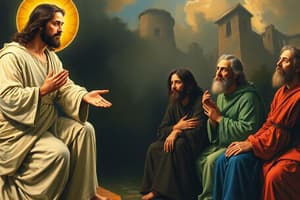Podcast
Questions and Answers
What is the turning point of chapter 1?
What is the turning point of chapter 1?
The Church pushed out on its own: The fall of Jerusalem and the destruction of the temple.
Was Titus correct in his reasoning about the destruction of the temple?
Was Titus correct in his reasoning about the destruction of the temple?
No, Titus was incorrect; Judaism was not abolished and is still present today.
Identify how the following books illustrate Christianity's connection to Judaism: Matthew, Luke, John, Epistle to James.
Identify how the following books illustrate Christianity's connection to Judaism: Matthew, Luke, John, Epistle to James.
Matthew: prophetic promises for the Messiah, Luke: Jewish law, John: divine revelation to Abraham had culmination in Jesus Christ, Epistle to James: God's consistent offer of grace to the Jews.
What does the great turning point of the destruction of the temple represent?
What does the great turning point of the destruction of the temple represent?
What change in perception was brought about by the smashing of Jerusalem?
What change in perception was brought about by the smashing of Jerusalem?
What questions were forced upon the church as a result of the events of A.D. 70?
What questions were forced upon the church as a result of the events of A.D. 70?
What three ways does Noll give that Christianity benefited from its Jewish roots?
What three ways does Noll give that Christianity benefited from its Jewish roots?
What are four existing conditions that accelerated the spread of Christianity?
What are four existing conditions that accelerated the spread of Christianity?
Summarize the course of Christian persecution.
Summarize the course of Christian persecution.
What is the three-fold means by which the church came into its own after A.D. 70?
What is the three-fold means by which the church came into its own after A.D. 70?
What are the two large difficulties facing the historian of this time period?
What are the two large difficulties facing the historian of this time period?
What is a most important factor for interpretations of early Christian history?
What is a most important factor for interpretations of early Christian history?
Describe how Noll uses Roman Catholic, Orthodox, and Protestant positions to make his case.
Describe how Noll uses Roman Catholic, Orthodox, and Protestant positions to make his case.
Define 'canon.'
Define 'canon.'
What are the practical circumstances that led to the need for a canon?
What are the practical circumstances that led to the need for a canon?
How many centuries did it take to define the precise shape of the New Testament canon?
How many centuries did it take to define the precise shape of the New Testament canon?
How did heresy play a decisive role in the necessity of a canon?
How did heresy play a decisive role in the necessity of a canon?
What is the name given to the earliest fragment found containing the list of the New Testament?
What is the name given to the earliest fragment found containing the list of the New Testament?
What was the key to determining whether a book should be included in the canon?
What was the key to determining whether a book should be included in the canon?
What is the interpretive difficulty with respect to the early history of the episcopate?
What is the interpretive difficulty with respect to the early history of the episcopate?
Summarize the arguments for episcopacy given by Ignatius, Irenaeus, and Cyprian.
Summarize the arguments for episcopacy given by Ignatius, Irenaeus, and Cyprian.
Summarize the difference between Roman Catholic and Protestant interpretation of the rise of the episcopate.
Summarize the difference between Roman Catholic and Protestant interpretation of the rise of the episcopate.
What two functions did the system of bishops serve in the church?
What two functions did the system of bishops serve in the church?
What function did creeds serve?
What function did creeds serve?
What are two types of creeds?
What are two types of creeds?
What century does the Apostles' Creed take its final form?
What century does the Apostles' Creed take its final form?
What are the older versions of this creed called and what century can they be traced back to?
What are the older versions of this creed called and what century can they be traced back to?
How did the creeds oppose the following heresies: Gnosticism, Docetism, Judaism, Marcionism?
How did the creeds oppose the following heresies: Gnosticism, Docetism, Judaism, Marcionism?
What are the three vehicles upon which the Christian Church traveled as it began its journey outward from Jerusalem?
What are the three vehicles upon which the Christian Church traveled as it began its journey outward from Jerusalem?
Flashcards are hidden until you start studying
Study Notes
Turning Point of Chapter 1
- The fall of Jerusalem and destruction of the temple marked the Church's independent mission.
Implications of the Temple's Destruction
- The temple represented the center of grace and divine connection for both Jews and Christians.
- Titus's belief that destroying the temple would annihilate Judaism was incorrect; Judaism persisted despite the loss.
- The temple's absence primarily affected Jews, symbolizing the end of their last stronghold.
New Testament's Relationship with Judaism
- Matthew highlights prophetic promises concerning the Messiah.
- Luke emphasizes adherence to Jewish laws.
- John illustrates the culmination of divine revelations in Jesus Christ.
- Epistle to James expresses God's offer of grace to the Jews.
Significance of the Temple's Destruction
- The destruction represented a shift in Christianity, expanding its reach beyond Judaism.
Change in Perception Post-Jerusalem's Fall
- The fall of Jerusalem signified Christianity's independence from Jewish roots.
Challenges Faced by the Church After A.D. 70
- The church faced questions on self-definition, worship organization, authority, and combating erroneous teachings.
- The transition from a Judaism framework prompted re-evaluation of identity.
Benefits from Jewish Roots
- Christianity derived ultimate truth from Jesus Christ's life and work.
- The church relied on New Testament writings and apostolic testimony.
- Retained legal status from Jewish traditions helped protect the church.
Conditions Accelerating Christianity's Spread
- Pax Romana facilitated travel and communication.
- Hellenistic culture promoted shared ideas.
- Jewish diaspora created a network of "God-fearers."
- Shift from a Jewish-centric identity to a broader mission-focused identity aided expansion.
Summary of Christian Persecution
- Persecution increased under Emperors Nero, Domitian, and Marcus Aurelius.
- Leaders' moral corruption led to more widespread persecution, impacting how followers practiced their faith.
Three Key Elements Shaping the Church Post A.D. 70
- Development of creeds, canon, and episcopacy were crucial for church identity and structure.
Historical Challenges
- Scarcity of evidence makes documenting this era difficult.
- Existing evidence lacks detail, resulting in unresolved questions regarding early Christian history.
Interpretative Factors in Early Christian History
- The historian’s standpoint significantly impacts interpretations.
Noll's Use of Church Positions
- Roman Catholicism emphasizes episcopacy.
- Orthodoxy leans on creeds for doctrine.
- Protestantism relies on canon for biblical authority.
Definition of 'Canon'
- Originally a measuring rod, now refers to the accepted books of the Bible.
Practical Needs for the Canon
- Established standards for worship, prayer models, theological unification, and set texts for translations.
Duration for Canon Formation
- It took over two centuries to define the New Testament canon.
Heresy and Canon Development
- Marcion's teachings in 144 A.D. prompted the necessity for a clearly defined canon to counter false doctrines.
Earliest Fragment of New Testament List
- The Muratorian Canon is the oldest known fragment listing New Testament texts.
Apostolicity as Canon Criterion
- The key consideration for inclusion in the canon was apostolic authorship.
Challenges with Early Episcopate History
- Early church order descriptions are ambiguous compared to later well-defined episcopal structures.
Arguments for Episcopacy
- Ignatius: Advocated for a hierarchy with bishops at the top.
- Irenaeus: Emphasized apostolic succession.
- Cyprian: Argued that bishops and the church are mutually dependent.
Roman Catholic vs. Protestant Episcopate Views
- Roman Catholics see bishops as inherently necessary.
- Protestants view bishops as elected figures within the church.
Functions of the Bishopric
- Bishops moderated church life and organized responses to external challenges.
Role of Creeds
- Creeds delineated true beliefs from heretical imitations, preserving apostolic teachings.
Types of Creeds
- Creeds can be categorized as Conciliar or Baptismal.
Apostles' Creed Final Form
- The Apostles' Creed reached its definitive version in the 7th century.
Older Creed Versions and Their Origins
- The Old Roman Creed (300 AD) and texts by Ignatius of Antioch (100 AD) are considered older versions.
Creeds Against Heresies
- Gnosticism: Affirmed God as creator and father.
- Docetism: Explained Christ's genuine human suffering and existence.
- Judaism: Defined Jesus unequivocally as the Messiah.
- Marcionism: Asserted the unity of Jesus and God against separation.
Vehicles for Christianity's Expansion
- The journey of the Christian Church was facilitated by canon, creed, and episcopate.
Studying That Suits You
Use AI to generate personalized quizzes and flashcards to suit your learning preferences.




